Published
on 8
Sep 2016
|
All rights reserved.
|
|
|
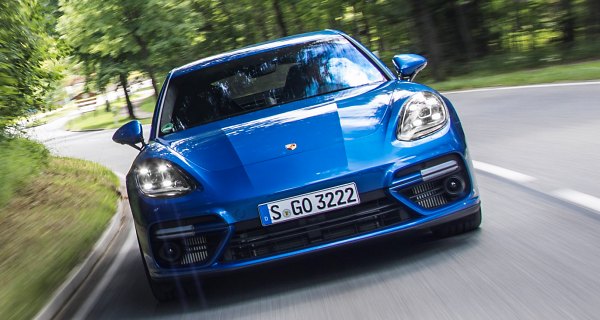 |
|
The
first Panamera lacked style and driver engagement. Can the Mk2 have
these sorted out?
|
|
The first generation
Panamera had mainly two problems: firstly, it looked huge, bulky and
ungainly. Secondly, although it was certainly very fast, it was not
very engaging to drive. Both sounded very un-Porsche. However, its
concept was basically correct. It enabled the famous sports car
manufacturer to expand its business into luxury car class traditionally
dominated by Mercedes, BMW and the like all the while maintaining a
clear performance edge. Moreover, it was relatively cost-effective to
build because it shared a lot of components with Cayenne, including
powertrains, suspension and all-wheel-drive system. This means it was
capable to breakeven with annual sales down to 12,000 units. Although
it turned out to be not as popular as Cayenne, it still managed to sell
nearly 160,000 units over its 7-and-a-half-year lifespan. This secures
the development of second generation.
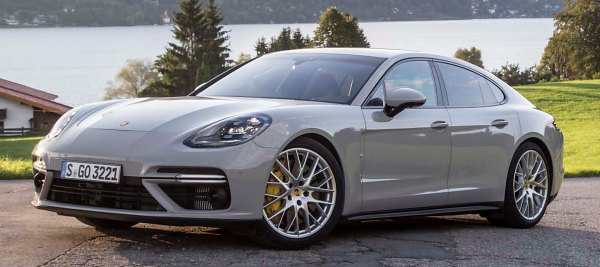 |
|
More
stylish than the last Panamera? Yes, but it fails to replicate the
beauty of 928...
|
|
Naturally, the most important task for Michael Mauer is to improve the
aesthetic of the new Panamera. There is no way to touch the car’s huge
dimensions, which actually get slightly larger again to provide ample
interior space and pack the sophisticated ingredients, but good
designers should find ways to hide the bulk and deliver a false
impression of sleekness. I would not declare the works of Mauer as
miraculous, but it is unquestionably more successful than last time. If
you compare the side profile of the old and new car, you will find the
latter appears to be sleeker. Both its roof line and shoulder line are
curvier. The tailgate gets faster, the tail gets slimmer and the
overall look of the back end is more akin to 911. The reshaped side
window looks more like 911’s as well, although it necessitates an extra
quarter window. Meanwhile, the more pronounced rear fenders look
sportier. The front end styling is also an improvement, although not
quite as obvious as the rear. The bonnet and front bumper get edgier.
The headlamps get larger and more pronounced from the bonnet in order
to appear more like 911. However, since the bonnet has to accommodate a
big engine, it still appears to be a bit bulky. It is quite
disappointing that the Panamera fails to replicate the sleek front end
of the classic 928. Yes, I know the
packaging constraints are different now and then (for instance, the
hot-Vee engine is inevitably taller), and pedestrian safety regulations
play a role, too, but still I can’t help feeling sorry that modern cars
get uglier.
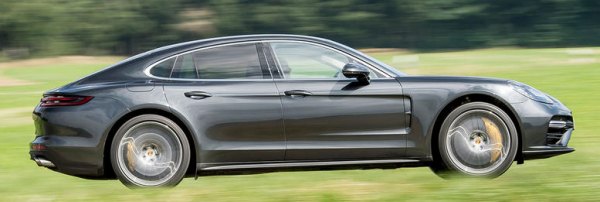 |
|
Its
roof line and shoulder line are curvier. The tailgate gets faster, the
tail gets slimmer...
|
|
The Mk2 Panamera has grown a little in all dimensions – 79mm longer,
6mm wider, 5mm taller and 30mm longer in wheelbase. It is still shorter
than all other performance luxury limousines, but wider than all except
Maserati Quattroporte. Its 1427 mm height is easily the lowest in the
class and is a clear indication to its sportier character. The slightly
longer rear overhang enables the boot to grow by 50 liters to 495
liters. Meanwhile, aerodynamic drag is unchanged from the old car, i.e.
0.29 for most models or 0.30 for the range-topping Turbo. A rear
spoiler normally recessed at the tailgate pops up at speed to cut lift.
On the Turbo, it also extends sideway to increase downforce further.
The new platform underpinning the car is called MSB. It is developed by
Porsche but will be shared with various Bentleys in the future. Body
construction is not a big departure from the last one though. It is
still primarily made of steel, with aluminum used as supporting roles
in areas such as crash structure, subframes and suspension towers. The
outer shell is mostly aluminum, including roof, bonnet, tailgate and
fenders. If you expected it to reduce weight like the rest of the
industry, you will be disappointed. At 1995 kg, the Panamera Turbo is
hardly a lightweight. In fact, it weighs the same as the outgoing Turbo
S which had the same power output. The base V6 model also weighs
exactly the same as before. So MSB is new, but we can’t see any
advancement it brings except the cost-saving modular nature.
 |
|
The
overall look of the back end is more akin to 911.
|
|
Changes to the suspension are also rather subtle. The double-wishbone
front and multi-link rear axles are basically carried over, ditto the
PASM adaptive dampers, PDCC active anti-roll bars and PTV-Plus torque
vectoring differential. The most significant change is the air
suspension (standard on Turbo and optional to others), which has been
upgraded to a 3-chamber design like the new Mercedes E-class for 60
percent increase of air capacity hence wider range of variation.
Another addition is rear-wheel steering, but it is not exactly a
headline because BMW already has it on its 7-Series, not to mention
cheaper cars like Renault Megane, Talisman and Acura RLX. The last
mentionable new item is the so-called “4D Chassis Control”, which is
actually a software thing that integrates the PASM, PDCC, PTV-Plus etc.
together. The 4-wheel-drive system is carried over from the old car as
well. It uses a multi-plate clutch located just behind the transmission
to send torque to the front axle, so the torque-split continues to be
rear-biased by default.
AWD is mandatory on all the 3 Panamera models available at launch:
Panamera 4S (powered by V6 turbo), 4S Diesel (V8 turbo diesel) and
Turbo (V8 turbo). The Turbo employs a new 4.0-liter twin-turbo V8,
which is 800 c.c. smaller than before but no less powerful. It is
developed in Weissach although it has many similarities with Audi’s
4-liter V8. Both feature hot-Vee architecture, i.e. the two twin-scroll
turbochargers are mounted inside the V-valley for compact packaging and
reduced turbo lag, while the cooler intakes breath from outside. Also
like the Audi V8, it features cylinder deactivation by means of Audi's Valvelift
mechanism, although misleadingly dubbed VarioCam Plus. In other words,
it uses moving pins and spiral grooves to switch between normal and
zero valve lift, therefore shutting down 4 of the 8 cylinders. Running
a
maximum boost pressure of 1.3 bar, the engine produces 550 horsepower
from a rather modest 5750 rpm. Peak torque of 568 pound-foot is
available between 1960 and 4500 rpm. (Remark: many publications quoted
the boost pressure as 0.3 bar, which is obviously impossible judging
from the
engine's very high specific power and torque.) As a result,
performance is
astonishing for such a big car. It would sprint from rest to 60 mph in
3.5 seconds and 100 mph in just over 8 seconds, faster than a 911
Carrera S turbo! It would top 190 mph on Autobahn, or lap Nurburgring
in 7 min 38 sec. The latter trails Alfa Giulia
Quadrifoglio by only 6 seconds. This is the fastest luxury sedan in the
world.
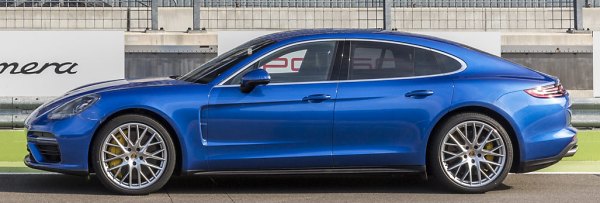 |
|
Despite
more aluminum used in its construction, Panamera Turbo still weighs a
good 2 tons.
|
|
The 2.9-liter twin-turbo V6 of Panamera 4S is derived from the same
modular family of the V8, but strangely, it was developed by Audi and
is closely related to the 3-liter single-turbo V6 of Audi S4. Needless
to say, it also employs hot-Vee architecture and 90-degree V-angle –
the latter necessitates the addition of a balancer shaft to smooth out
vibration. Running up to 1.4 bar boost pressure, it produces 440 hp and
406 lbft of torque, not quite in the same league as the aforementioned
Alfa Romeo Giulia QF but is nonetheless powerful (think of 959 power
from a similar capacity). The car tops 179 mph and achieves 0-60 mph in
4.1 sec.
The Panamera 4S Diesel is quite a super oil-burner. Its 4-liter diesel
V8 is sourced from Audi and derived from the similar motor serving SQ7,
but it is
stripped of e-booster (electric compressor), leaving the sequential
twin-VTG turbochargers to produce 422 hp and 664 lbft of torque – the
latter is available from as low as 1000 rpm! Even though the car weighs
some 2050 kg, it is good for 177 mph and 0-60 in 4.2 seconds. In other
words, the fastest diesel car in the world.
All 3 engines mate with a new 8-speed PDK twin-clutch gearbox supplied
by ZF. Don't be too excited with its increased ratios, because it still
reaches top speed at 6th, whereas 7th and 8th are overdrive to save
fuel. Manual gearbox? Sorry, it died together with the last generation
Panamera GTS.
On the Road

|
|
Gloss-black
touch-sensitive panel looks much simpler and more modern, but
touch-sensitive buttons could be difficult to find when you are
driving.
|
|
Open the door, you will find a spacious and properly luxurious cabin.
You sit low on the supportive bucket seat, facing a 918-style steering
wheel (with plenty of handy switches) and a modern instrument
consisting of a conventional tachometer flanked by a pair of LCD
screens. Interestingly, those screens can be reconfigured to display
Porsche’s traditional 5-gauge instrument together with the tachometer.
The center console is dominated by a large, 12.3-inch touch screen and
a gloss-black touch-sensitive panel, which looks much simpler and more
modern than the button-rich console of the old car, although
touch-sensitive buttons could be difficult to find when you are
driving. The materials and craftsmanship are no match with Mercedes
S-class, of course, and the design is rather unimaginative, but the
build quality of Porsche is never in doubt. At the back, the individual
rear seats are inevitably less spacious than the usual standards of
luxury limousines, but passengers up to 6ft 4in will find them
comfortable. Although the roof line has been lowered at the rear for
styling purpose, the new car has its seats mounted lower thus it still
offers ample headroom. Legroom is also more than adequate for those 6ft
4 guys. Entertainment provided to them is not as generous, as there is
only a small screen at the rear transmission tunnel. Forget about
airliner seats, massagers, folding tables or wine cabinet. This is a
Porsche, not Maybach.
Start the V8 engine, it burbles into life in a civilized manner. With
optional sport exhaust it might be a little louder than Audi’s V8, but
still it is too civilized for a Porsche, even a luxurious one. The
turbocharged V8s of Mercedes-AMG and Maserati sound angrier and more
thrilling. As it is quite subdued, and the cabin’s sound insulation is
quite effective, the Panamera Turbo feels slower than it is. In
absolute terms it might be as fast as some supercars, but unfortunately
you can’t feel that. Comparatively, the V6 feels peppier. It is smooth
yet strong enough, and it makes a more exciting whine at the top end.
The lighter car also feels more nimble. In contrast, the V8 diesel is
all about low-end torque, instant acceleration and relaxed cruising.
It’s a great diesel engine but not necessarily a great Porsche engine.
No complaints for the 8-speed PDK gearbox as it serves up quick and
smooth gearchanges. Moreover, it is capable to handle up to 738 lbft of
torque, cool!
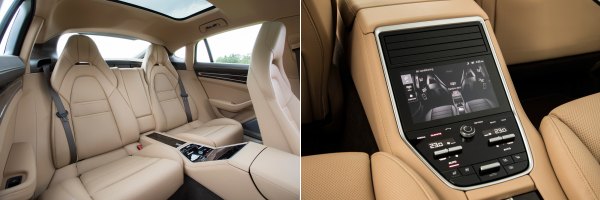
|
|
Individual
rear seats are inevitably less spacious than the usual standards of
luxury limousines, but those up to 6ft 4in will find them comfortable.
|
|
The most impressive of the new Panamera is its ground-covering
capability. It cruises at high speed with immense stability, composure
and quietness. Its air suspension glides over expansion joints and
speed bumps with ease. In corner, the grip it produces and the
resistance to pitch and roll is well beyond the levels of any other
performance limousines. Push it harder and you can feel the power
shifts forward to stablise the car, but the rear rubbers refuse to give
up. Now you understand why it could do so well in Nurburgring. The new
electrical power steering is quick and precise, letting the big car to
feel smaller than it is in twisty roads. Nevertheless, it is still
short of communication with the front wheels. Moreover, like anything
else in the class, the sheer size of the car prevents the driver from
pushing on narrow country roads. You will be happier to push a BMW M5
on the same roads.
In many ways, the Panamera seems like a car for every situation. It
serves the roles of luxury limousine, Autobahn missile and Nurburgring
hero equally well. However, as a Porsche, the driving thrills it brings
are modest. A more communicative steering, more characterful exhaust
note and maybe a bit more interactive chassis balance could be the
answer. The slightly bulky front-end design and the disciplined
interior design fail to inspire excitement as well. As a result, it has
to settle with 4-star rating, even though it is undoubtedly the most
capable performance luxury sedan currently on offer.
|
Verdict:     |
Published
on 19
Jan 2017
|
All rights reserved.
|
|
Panamera 4 E-Hybrid
|
|
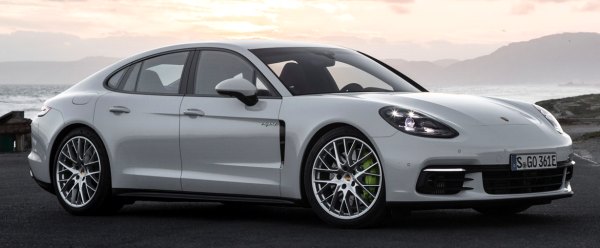
|
|
Faster,
greener and offers a longer EV range, the new E-Hybrid improves on
every aspect, except weight.
|
|
This is the second
generation Panamera E-Hybrid, or the plug-in hybrid version of the
Porsche performance limousine. The “4” in its name implies that it has
gained 4-wheel-drive system as standard, just like all other
derivatives of Panamera. Its powertrain looks similar to the one of its
predecessor, but it is actually brand new. The 2.9-liter twin-turbo V6
is taken from Panamera 4S, but detuned to 330 horsepower and 332 lbft
of torque for the interest of fuel economy. The electric motor is
installed inside the housing of the 8-speed PDK gearbox, which replaces
the old car’s Tiptronic automatic. It produces another 136 hp and 295
lbft, a significant improvement from the old car’s 95 hp and 228 lbft.
As a result, the combined output is lifted by 46 ponies to 462 hp, and
maximum torque surges from 435 to 516 lbft. Unsurprisingly, the new
E-Hybrid is faster. It takes 4.4 seconds to go from zero to sixty, and
flat out at 172 mph on Autobahn, though it still trails the Panamera 4S
a little bit.
Not just quicker, the new E-Hybrid improves on virtually every aspect.
Its boot-mounted battery is enlarged from 9.4 to 14.1 kWh, enabling the
EV range to be extended from 36 to 50 km (31 miles). Like the rest of
the Panamera range, the new car looks relatively stylish, has air
suspension fitted standard for better ride quality, and its cabin is
roomier, more advanced and better built. The only drawback is
additional weight. It tips the scale at an eye-popping 2170 kg DIN,
some 95 kg more than its predecessor, and a full 300 kg heftier than
Panamera 4S!
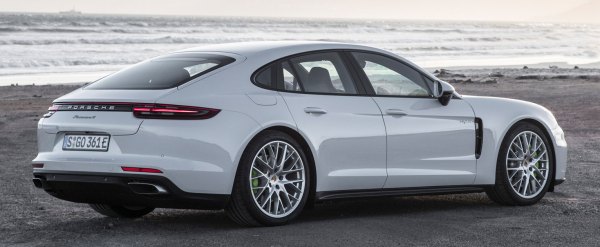
|
|
Still
a very competent luxury car, but not fast or engaging enough to win
driver's heart.
|
|
On the road, the electric-petrol power integration is close to
seamless, just as you would expect for a properly-developed hybrid
nowadays. However, when the V6 breaks the electric silence, its does
that with a gruffy soundtrack, which is a stark contrast to the superb
refinement you enjoyed before. The PDK box is slightly disappointing,
too, as it does not shift as smoothly as the old Tiptronic or the
versions on other Panameras. Still, there is plenty of performance on
offer. While the old car needed at least 80 percent throttle travel to
engage the electric motor, the new car has the electric power available
constantly. Its 516 lbft of maximum torque is available from merely
1100 rpm and sustains until 4500 rpm, so the car feels effortlessly
quick. It becomes less energetic when the battery is depleted, but you
have to do some very hard laps to reach that state, which is something
not expected to happen often on a limousine like this.
However, the weight does handicap its handling a little. No Panameras
could be described as truly agile, but the E-Hybrid feels even less so
than the lighter 4S. It serves the role of Autobahn cruiser very well,
but on a narrow twisty mountain road, you feel its width and its weight
hurting its maneuverability. Like all its siblings, its steering is
accurate but lacks feel. Its chassis offers good grip and body control
but none of the throttle steer of a performance sedan deserves. An M5
or E63 must be far more engaging to drive. Worse still, its bland of
mechanical and regenerative braking is flawed. The first few
centimeters of the brake pedal travel feels soft, and then it suddenly
firms up when the brake pads finally touch the discs. Porsche did the
braking perfectly in 918 Spyder, but that car has a direct-drive motor
at the front axle thus could be easier to tune.
All in all, the E-Hybrid is the least rewarding to drive among its
siblings. It is still a very competent luxury car, but if you want
performance and thrills, you had better to look elsewhere. Curiously,
Porsche prices the car slightly below the 4S, even though it shares
that car’s V6 and adds the expensive battery and electric components.
It must be sold at a heavy incentive.
|
Verdict:    |
Published
on 23
Jul 2017
|
All rights reserved.
|
|
Panamera Sport Turismo
|
|

|
|
Sport
Turismo adds a little more luggage space, rear headroom and the fifth
(occasional) seat at minimum costs.
|
|
The Panamera Sport Turismo
is not a wagon or estate. The word “Sport” implies more aesthetic than
conventional wagons but also less cargo-carrying capability. In fact,
compared with the standard Panamera hatchback its offers only 25 liters
more luggage space. With the rear seats folded and load up to the roof,
the gap widens to 86 liters, but then it is still too small to be
qualified a wagon. More welcomed is the increased rear headroom and
easier access to the cabin. The ST has its roof extended rearward, so
it affords more headroom for rear passengers. The rear doors have the
same length, but their windows are squarer, so the roof rails are less
obstructive. This puts the Panamera in a better position to steal sales
from conventional luxury limousines. Unfortunately, the rear seats
don’t. Although Porsche has converted the 2 individual seats into a
bench seat, the middle passenger is punished with a thin and hard
cushion, and legroom is totally occupied by the wide transmission
tunnel. Bear in mind that the Panamera is much lower than other
limousines, its floor and seats are also lower thus the transmission
tunnel protrudes more into the cabin. The middle rear seat is suitable
only to children for short trips. No wonder Porsche calls it 4+1
seating.
Some people prefer the looks of the Sport Turismo to the Panamera
hatchback. For a wagon, yes, it does look pretty nice, although you
might say the same to a Mercedes CLS Shooting Brake or Ferrari GTC/4
Lusso. However, its flat roof loses the visual connection to Porsche,
or the pretension of a 911 saloon. That said, the pronounced rear
fenders work well with the squarer tail and deliver a more muscular
perception than the hatchback. It actually looks sportier than the
somewhat civilized hatchback.
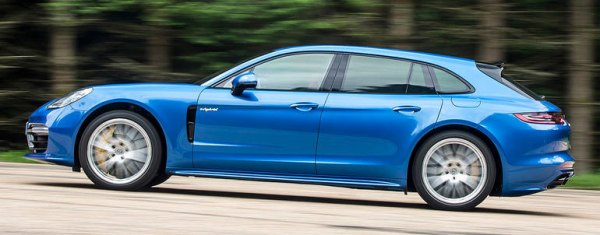
|
|
It
actually looks sportier than the somewhat civilized hatchback.
|
|
The conversion adds 40kg to the kerb weight. Since all powertrains are
the same, there is negligible loss of performance – Porsche quotes
exactly identical figures. The chassis setting is also unchanged as the
additional load to rear axle is too little. It remains a very fast and
capable car on wide open roads. Great body control, nice ride quality
and strong roadholding matched with decent feedback. It is a sport car
compared with an AMG S-class, BMW M760 or even a Maserati Quattroporte,
but it is not quite as agile as smaller E-segment sports saloons, nor
it is as thrilling to drive as an AMG E63 S. The ST widens the scope of
Panamera a little, but it is still a niche choice in the market.
|
Verdict:     |
Published
on 9
Aug 2017
|
All rights reserved.
|
|
Panamera Turbo S E-Hybrid
|
|
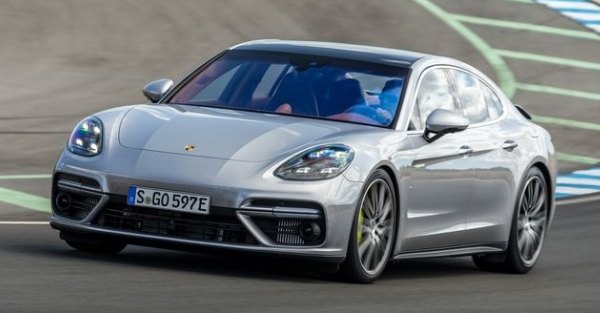
|
|
Instantaneous
performance is not everything.
|
|
The last generation
Panamera Turbo S was just a more powerful version of Panamera Turbo.
Surprisingly, the new Turbo S becomes a hybrid. It mates the regular
Turbo's 550hp V8 with the E-Hybrid's 136hp electric motor, which is
situated in the 8-speed PDK gearbox thus is theoretically compatible
with any engines of the Panamera. When both power sources work at full
steam, they provide a staggering 680 horsepower and 627 pound-foot of
torque, and the latter is available from just 1400 rpm to as high as
5500 rpm. This means performance is instantaneous. Meanwhile, the
Panamera’s 4WD system makes good use of the tremendous torque to
deliver jaw-dropping acceleration, which is quoted to be 0-60 mph in
3.3 seconds. That is Porsche’s figure, so you can expect sub-3 by
third-party road tests. Compared with Turbo, the new range-topper is
0.2s and 0.5s quicker to 60 and 100 mph respectively. In-gear
acceleration should be quicker still, as its powertrain does not need
to pile up revs to deliver peak torque. Whenever you need acceleration,
it delivers instantly. The advantage over Turbo is especially obvious
at lower revs. At the top, the electric power fades out. Top speed is
193 mph, only 3 mph higher than the Turbo.
The 14.1kWh lithium battery (like the lesser E-Hybrid again) allows the
car to run silently by electric power for about 50km, good enough for
commuting to pubs or supermarkets. Using 230V / 32A fast charger, it
takes 2.4 hours to charge up.
Unfortunately, straight line performance aside, the car falls behind
the lesser Turbo in all other aspects. The hybrid package consisting
of electric motor, inverter and battery adds as much as 315 kilograms
to the kerb weight, resulting in a Bentley-rivalling 2.3 tons. The car
has all performance options fitted standard, such as PDCC active
anti-roll bars, 4-wheel steering, carbon-ceramic brakes and 21-inch
wheels, which are necessary to accommodate those 420/410mm discs.
However, they are more about keeping the car tidy in corners rather
than adding feel or agility. On the road, you can feel the lighter
Turbo slightly more agile and more precise at the limit, the steering
weightier and more natural, the ride more composed on poor roads, and
the brake pedal more linear. The downgrades are slight but perceptible.
If Porsche’s E-Hybrid technology cannot overcome such compromises, I
would not wish to see it to be adopted on future 911s. As for the case
of Panamera, you can keep the Turbo and save the £24,000 premium,
or even better, opt for an AMG E63 S and save 50 grand.
|
Verdict:     |
Published
on 19
Oct 2020
|
All rights reserved.
|
|
Panamera Turbo S
|
|
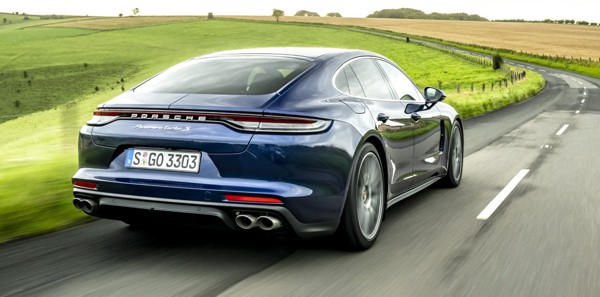
|
|
After
4 years, the Turbo S returns as the performance flagship of Panamera.
|
|
Over the past 4 years, one
nameplate was strangely omitted from the Panamera Mk2 family: Turbo S.
This should have been the performance flagship of the range. Maybe
Porsche thought the 550hp Turbo was good enough to beat the
competition. Maybe it wanted to shift the limelight to the Turbo S
E-Hybrid, an electrified, 680hp monster that ran from rest to 60 mph in
3.3 seconds.
However fast that model on a straight line is, it weighs a
Bentley-rivalling 2310 kilograms, thus is impossible to fly on a more
challenging road, so that it can never be a direct replacement for the
Turbo S. That’s why the Turbo S returns, and the Turbo is withdrawn.
Somehow unfashionable in 2020, the Turbo S receives no form of
electrification at all. Its 4-liter twin-turbo V8 seeks increased power
from conventional means, i.e. new turbos, pistons, con-rods, crankshaft
and a higher pressure fuel injection. The result is 630 horsepower and
605 lbft of torque, the highest among all versions of 4.0-liter V8s
employed across the Volkswagen group. The new car gains 85kg from the
last generation Turbo S, but it undercuts the Turbo S E-Hybrid by
230kg. That’s why it is clearly the faster car, sprinting from rest to
60 in 3 seconds flat and, flat out, topping 196 mph. Well, the electric
Taycan is faster again, but as far as a large luxury saloon/wagon is
concerned, the Panamera Turbo S is as quick as you can get. When fitted
with optional Pilot Sport Cup 2 tires, it even lapped Nurburgring in
7:29.91, becoming the fastest executive car there.
On the chassis side, there is virtually no mechanical updates, but the
experience gained in the development of other Porsche models,
especially the Taycan, helps retuning the software of its air
suspension, active anti-roll bars and rear-wheel steering.
Carbon-ceramic brakes are standard.
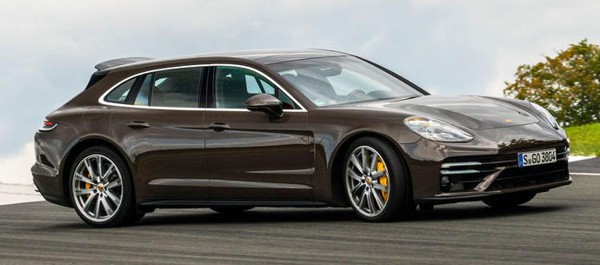
|
|
Its
combination of performance and refinement isclose to perfection...
|
|
On the road, the Turbo S is close to perfection. On the one hand, it
keeps the rolling refinement high, well worth the luxury car title. On
the other hand, performance is peerless. The V8 engine is powerful yet
has little hint of turbo lag. Throttle response is great, torque is
everywhere, and the PDK twin-clutch gearbox shifts crisply. The only
downside is a slightly muted exhaust note, lacking the drama of AMG,
BMW or Aston Martin’s V8s.
Likewise, the ride and handling is remarkable for such a large car. The
recalibration of various systems results in good control of roll, and
the steering, the agility afforded by 4WS and the brakes are all up to
very high standards. In the field of F-segment performance limousines,
it is in a class of its own – admittedly, the same can be said to the
old Turbo. Compared with AMG GT63 S 4-door, E63 S or BMW M5
Competition, the big Panamera Turbo S still matches most of their
capabilities, except that its AWD drivetrain lacks a pure rear-drive
mode.
This makes it less playful on a track, if not a serious concern on a
public road. Unlike those rivals, the Panamera Turbo S is a more
civilized, more luxurious car. It sounds a bit un-Porsche, but in case
you are after maximum driving thrills, you might have already purchased
a 911 Turbo S or, if 4 seats are essential, a Taycan Turbo S. The
Panamera serves for a different purpose.
|
Verdict:     |
|